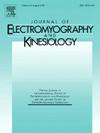Effects of neuromuscular training on proprioception and muscular reaction time in older woman: Randomized controlled trial
IF 2.3
4区 医学
Q3 NEUROSCIENCES
引用次数: 0
Abstract
Background
this study aimed analyze the effects of a neuromuscular training program compared to a multicomponent training program on proprioception and muscle reaction time in older woman.
Material and methods
Randomized controlled trial, included 54 older women randomized into 3 groups: multicomponent group (MCG), neuromuscular group (NMG), and control group (CG). Proprioception was assessed using the active repositioning test in the shoulder, elbow, hip, and knee joints. The muscular reaction time of the peroneus longus, tibialis anterior, and gastrocnemius medialis were evaluated. MCG carried out a multicomponent training program and, NMG realized neuromuscular training program plus the multicomponent training.
Results
A significant time × group interaction was observed in proprioception the shoulder joints (F = 7.57; p = 0.003; ηp2 = 0.255), hip joints (F = 10.2; p = < 0.001; ηp2 = 0.258) and knee (F = 7.12; p = 0.004; ηp2 = 0.244) and reaction time of the peroneus longus (F = 13.7; p = < 0.001; ηp2 = 0.378), tibialis anterior (F = 8.14; p = 0.002; ηp2 = 0.246) and gastrocnemius medial (F = 7.86; p = 0.003; ηp2 = 0.263). Multiple comparisons showed that there are significant improvements between the pre-and post-assessment of the NMG in proprioception and muscle reaction time.
Conclusions
Neuromuscular training program enhances the effects of multicomponent training and should be included in the physical activity programs of older people.
神经肌肉训练对老年妇女本体感觉和肌肉反应时间的影响:随机对照试验
本研究旨在分析神经肌肉训练计划与多组分训练计划对老年妇女本体感觉和肌肉反应时间的影响。材料与方法将54例老年妇女随机分为3组:多组分组(MCG)、神经肌肉组(NMG)和对照组(CG)。采用主动重新定位试验评估肩膀、肘关节、髋关节和膝关节的本体感觉。观察腓骨长肌、胫骨前肌和腓肠肌内侧肌的肌肉反应时间。MCG组采用多组分训练方案,NMG组采用神经肌肉训练方案加多组分训练。结果肩关节本体感觉存在显著的时间×组交互作用(F = 7.57;p = 0.003;ηp2 = 0.255),髋关节(F = 10.2;P = <;0.001;ηp2 = 0.258)和膝关节(F = 7.12;p = 0.004;ηp2 = 0.244)和腓骨长肌反应时间(F = 13.7;P = <;0.001;ηp2 = 0.378),胫骨前肌(F = 8.14;p = 0.002;ηp2 = 0.246)和腓肠肌内侧肌(F = 7.86;p = 0.003;ηp2 = 0.263)。多重比较表明,NMG评估前后在本体感觉和肌肉反应时间上有显著改善。结论神经肌肉训练方案能提高多组分训练的效果,应纳入老年人体育锻炼方案。
本文章由计算机程序翻译,如有差异,请以英文原文为准。
求助全文
约1分钟内获得全文
求助全文
来源期刊
CiteScore
4.70
自引率
8.00%
发文量
70
审稿时长
74 days
期刊介绍:
Journal of Electromyography & Kinesiology is the primary source for outstanding original articles on the study of human movement from muscle contraction via its motor units and sensory system to integrated motion through mechanical and electrical detection techniques.
As the official publication of the International Society of Electrophysiology and Kinesiology, the journal is dedicated to publishing the best work in all areas of electromyography and kinesiology, including: control of movement, muscle fatigue, muscle and nerve properties, joint biomechanics and electrical stimulation. Applications in rehabilitation, sports & exercise, motion analysis, ergonomics, alternative & complimentary medicine, measures of human performance and technical articles on electromyographic signal processing are welcome.

 求助内容:
求助内容: 应助结果提醒方式:
应助结果提醒方式:


